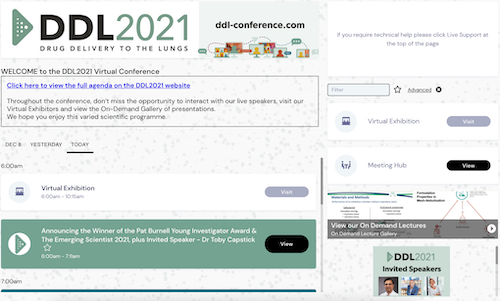The 2021 Drug Delivery to the Lungs conference featured a variety of topics of particular interest to the OINDP community in 2021, including COVID-19, digitalization, nasal drug delivery, and reducing the environmental impact of MDIs, as well as how to deal with the tobacco industry’s entry into the field. In addition, topics of perennial interest such as formulation (particularly for DPIs), analytical methods, and new targets for inhaled drugs also received their due.
This year’s DDL presentations originated from the usual home of DDL, the Edinburgh International Conference Centre (EICC), but with only a handful of DDL committee members on site in Edinburgh. Everyone else who participated in the meeting — more than 500 delegates, presenters, and organizers — joined the conference from homes and offices around the world through the EICC’s virtual attendee portal.
Most of the scientific programming took place live on UK time, including nine invited speakers, nine flash presentations, the winner of the Emerging Scientist Award, and the four finalists for the Pat Burnell Young Investigator Award. Delegates also had access to a gallery of more than 40 on-demand presentations and more than 30 sponsor exhibits. Although the live portion of the meeting is now complete, delegates will continue to have access to all of the presentations and virtual exhibits until January 10, 2022.
Considerations for treatment with inhaled drugs
The meeting kicked off with the DDL Annual Lecture, “a prestigious accolade bestowed on individuals who have contributed much to the field of respiratory science,” which was delivered by Sabine Häussermann of VisionHealth. In her presentation, titled “Digitalization in respiratory medicine, where are we heading to?”, Häussermann reviewed a number of applications for artificial intelligence currently in use in the respiratory field, including spirometry, symptom checkers, pulmonary rehab, and her own company’s inhaler trainer. She also addressed the “pain and gain of digitalization,” noting that while machines lack the common sense and empathy of humans, AI can do time consuming tasks gaining clinicians back the time necessary to focus on the patient. Some main sources of pain, she said, include bad algorithms that yield bad conclusions and the current lack of standards for data protection. Overall, she suggests, the combination of human and machine is superior to either alone.
Two of the speakers on the first day brought up new considerations for treatment with inhaled drugs. David Price of the University of Aberdeen addressed a new GINA recommendation for the use of ICS-formoterol as a reliever medication in preference to a SABA reliever where possible. Price called the idea of using formoterol as a reliever only and not for regular use in mild asthma “quite a radical step forward” and suggests that perhaps solving the adherence problem for mild asthma patients is unnecessary. Among other new possible treatment regimens, he discussed the use of biologics at a much earlier stage, replacing ICS-LAMA or LABA controller therapy, and reserving those inhaled drugs for treatment of exacerbations.




